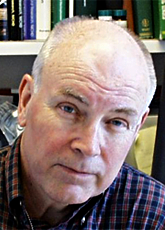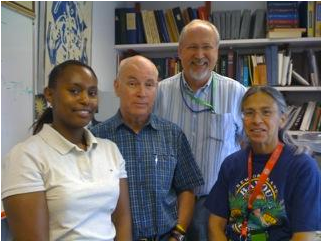You are here: Home > Mass Spectrometry Core Facility
NICHD Biomedical Mass Spectrometry Facility

- Alfred L. Yergey, PhD, Principal Investigator, Director
- Peter S. Backlund, PhD, Staff Scientist, Deputy Director
- Nancy E. Vieira, MS, Senior Research Assistant
- Stephanie Cologna, PhD, Intramural Research Training Award Fellow
- Christopher A. Crutchfield, PhD, Intramural Research Training Award Fellow
- Elizabeth Ogbonna, BS, Contractor
The NICHD Mass Spectrometry Core Facility was created under the auspices of the Office of the Scientific Director to provide high-end mass-spectrometric services to all NICHD scientists, particularly in the area of protein characterization, including identification through partial sequencing and detection of post-translational modifications. The facility also performs quantitative analyses of small molecules, including lipids and steroids and is located in the 9D corridor of Building 10 on the NIH campus.
Mode of operation

NICHD Biomedical Mass Spectrometry Facility Staff
Left to right: E. Ogbonna, A. Yergey, P. Backlund, N. Vieira
The facility's staff are available for consultation to everyone within the Institute, provided that existing resources are distributed equally among investigators requesting our services. Except for the ABI Voyager MALDI TOF (MALDI: matrix-assisted laser desorption/ionization; TOF: time-of-flight) instrument, none of the equipment is available for general use. The philosophy of the Facility is to ensure that its instruments obtain only reliable, high-quality data and that its clients receive only statistically meaningful analyses. For every new project, staff members meet with the Principal Investigator (PI) and other postdoctoral scientists involved in the study to discuss details of the experimental design. The discussion focuses on the project's background and analytical goals in order to determine the most appropriate techniques for sample preparation before delivery of samples to the Facility. For protein characterizations, we digest the proteins in situ, typically gel-separated by the investigator, and then isolate peptides for mass-spectrometric analysis. We subject the peptides to analysis by fragmenting them in a second-stage mass-spectrometer operation and then use the fragmentation spectra as input for database search engines to determine the protein(s) present in the original sample. Upon completion of an analysis, we provide the investigators with the results and review the findings. Long-term user feedback indicates that our high level of interaction with researchers has greatly improved the quality and utility of results of each project undertaken.
Instrumentation
The facility currently has five mass spectrometers in use for specific areas of analysis.
- ABI 4800 MALDI TOF/TOF. The state-of-the-art high-performance instrument can be operated in both positive- and negative-ion modes. We typically use it for peptide mixtures without chromatographic separation, although recently developed methodology now allows us to perform LC-MALDI analyses where the separations are performed off-line prior to mass spectrometry. Additional uses include accurate determination of peptide masses in complex mixtures and the determination of sequences of unusual peptides through de novo sequencing techniques.
- Thermo-Finnigan LCQ Deca. The instrument is used exclusively for protein characterization by LC-electrospray ionization to separate and ionize peptides that are then fragmented. It yields data that are complimentary to those produced by the MALDI TOF/TOF and is typically used in cases where the MALDI TOF/TOF yields ambiguous or incomplete results.
- ABI Voyager MALDI TOF. The instrument is used for analysis of higher molecular-weight species—equal to or less than 125 kDa—and to verify the molecular weight of intact proteins. The instrument is also available for general use after a potential user has undergone appropriate training.
- Agilent 6520 LC-ESI qTOF. The state-of-theart hybrid instument is currently used exclusively to determine cardiolipins in serum, but its great potential for a wide range of applications will be developed as the cardiolipin project begins to wind down over the next 9–15 months.
- Agilent 6460 LC-ESI QqQ (Triple Quad). The new state-of-the-art triple quad instrument is currently being heavily used for small-molecule analysis, principally for urinary steroid profiling and determination of small metabolites of the glyolytic pathway.
Facility usage
The Mass Spectrometry Facility currently serves 15 sections within the institute, representing about 40 projects, as well as four PIs of sister institutes on the NIH campus.
Major projects
Protein characterization in Niemann-Pick disease-Type C (NPC). Differentially expressed protein spots were isolated from Npc1 mutant female mice and littermate controls at 1, 3, and 5 weeks of age, and using mass-spectrometric techniques. We have candidate identifications to date on more than 200 pairs of protein spots. Of the proteins identified, we are continuing functional assays of a number of candidates with potential involvement in liposomal storage diseases and neuronal degeneration. To date, two candidates of particular interest are transthyretin and fatty acid–binding protein. Although these protein identifications were made from mouse brain, both are intriguing potential biomarkers in human cerebral spinal fluid (CSF). One reason for this is that decreased levels of CSF transthyretin correlate with disease severity in Alzheimer's disease, and elevated levels of fatty acid–binding protein have been found in the CSF of NPC patients.
CSF profiling in NPC. Initial experiments demonstrated that our novel analytical approach to compare protein profiles using MALDI TOF (Matrix Assisted Laser Desorption Ionization-Time Of Flight) mass spectrometry can detect significant differences between CSF from NPC patients and adult controls. CSF samples were collected from 37 well-characterized NPC patients. Currently the collection for NPC patients includes longitudinal samples collected over 2.5 years and five pre/post miglustat treatment pairs. In addition, collection of pediatric CSF samples is in progress at Childrens National Medical Center. In addition to the use of our Analysis Of VAriance coupled with Principal Component Analysis (ANOVA-PCA) analytical approach to MALDI-TOF profiling, we have begun the process of confirming proteins found in these CSF samples through the use of shotgun proteomics methodology, albeit on less complex systems than those to which this approach is generally applied. The proteins in the CSF will be quantified once digested for shotgun analysis using isotopically coded tags such as iTRAQ.
Lipid quantification in serum. We have continued developing methodology to quantify cardiolipins in human serum as part of a clinical study under way in the Institute to evaluate the effects of antibiotic treatment of pregnant women colonized with the Group B streptococcal (GBS) organism. The hypothesis being tested is that the typical peri-natal penicillin treatment gives rise to a large increase of circulating cardiolipins in the infant, which then leads to respiratory distress. It has been demonstrated in newborn sheep treated with penicillin that the GBS organisms secrete a specific cell-wall membrane cardiolipin and that this substance causes respiratory distress at levels corresponding to the injection of about 100 pmole/mL in serum, a concentration that falls rapidly with a half life of a few minutes. It is not known whether the respiratory distress observed in a fraction of infants born to GBS–colonized mothers is the result of a similar effect or caused by a release of endogenous cardiolipins stimulated by the bacterial death. The analytical approach involves the addition of an internal standard to a 200 uL serum sample, extractions by a combination of liquid-liquid and solid phase, followed by an LC-MS analysis that incorporates an extraction/recovery standard to monitor system quality control. We showed that cardiolipin can be extracted from serum with approximately 90% efficiency and that normal adult serum levels of (18:2)-4 cardiolipins are less than 10 fmole/uL, approximately 1000-fold lower than found by earlier, less accurate measurements. Recent measurements using a new instrument (sensitivity more than 100-fold greater and with mass accuracy of <10 ppm for the singly charged ions) consistently showed that (18:2)-4 levels in normal adult serum vary between 3 and 10 fmole/uL, with biological variations far greater than replicate measurements of an individual sample. In addition, other cardiolipins with saturated fatty acid moieties were detected in several individuals.
New approach to mass spectrometry–based protein identification. Current approaches to protein identification rely heavily on database matching of fragmentation spectra, while ignoring (in a scoring sense) the mass accuracy of the precursor ions. We developed a method based originally upon MALDI TOF-TOF instrumentation that uses targeted peptide-mass fingerprinting results to confirm MS/MS database search identifications. The method uses first-order spectral data that have so far been ignored by most search engines. In this method, the distribution of mass errors of peptide matches in the first-order spectrum is used to develop a probability model that is independent from MS/MS database search identifications. Peptide mass matches can come from both precursor ions that have been fragmented as well as those that are tentatively identified by accurate mass alone. This additional confirmation enables us to assign protein identifications to MS/MS based scores that are otherwise considered of only moderate quality. The probability model employed uses Bayesian Inference and the mass errors in the first-order spectra to assign peptide probabilities, and the product of individual peptide probabilities yields the final protein scores. Results based on a commercially available standard mixture of intact proteins showed very high confidence levels for the proteins found in a 1D gel separation of the mixture and also demonstrated that so-called one hit wonders found in fragmentation experiments can be validated reliably using this method. We believe that the method is applicable to LC-MS/MS methodologies that have precursor mass ion accuracies of at least 100 ppm.
Community outreach
The Mass Spectrometry Facility is committed to promoting mass-spectrometric aspects of proteomics and other mass-spectrometric analyses in NICHD's Division of Intramural Research. We make serious efforts to educate investigators on the benefits and pitfalls of the techniques used in the Facility. In particular, we provide coaching on the principles of appropriate methods for sample isolation and staining of gels. We also support an NIH-wide seminar series featuring internationally known experts in proteomics. In parallel, the staff of the Facility have developed collaborations with other Institutes to promote exchange of information and to bring new mass-spectrometric techniques to NICHD. In addition, Peter Backlund, Deputy Director of the Facility, is the coordinator of the NIH Mass Spectrometry Interest Group.
Additional Funding
- Bench to Bedside (2010): Development of combination therapy for Niemann-Pick Disease, type C
Publications
- Olson MT, Epstein JA, Sackett DL, Yergey AL. Production of reliable MALDI spectra with quality threshold clustering of replicates. J Am Soc Mass Spect 2011;11:969-975.
- Neunuebel MR, Chen Y, Gaspar AH, Backlund P, Yergey A, Machner MP. De-AMPylation of the small GTPase Rab1 by the pathogen Legionella pneumophila. Science 2011;333:453-456.
- Koshimizu H, Cawley NX, Kim T, Yergey AL, Loh YP. Serpinin: a novel chromogranin A-derived, secreted peptide up-regulates protease nexin-1 expression and granule biogenesis in endocrine cells. Mol Endocrinol 2011;25:732-744.
Collaborators
- Paul Blank, PhD, Program in Physical Biology, NICHD, Bethesda, MD
- Jonathan Epstein, MS, Molecular Genomics Laboratory Core Facility, NICHD, Bethesda, MD
- Peter Harrington, PhD, Ohio University, Athens, OH
- Rachel O. Loo, PhD, Molecular Biology Institute, UCLA, Los Angeles, CA
- Matthew Olson, MD, The Johns Hopkins University Medical School, Baltimore, MD
- Forbes Porter, MD, PhD, Program in Developmental Endocrinology and Genetics, NICHD, Bethesda, MD
- John Robbins, MD, Program in Developmental and Molecular Immunity, NICHD, Bethesda, MD
- Dan Sackett, PhD, Program in Physical Biology, NICHD, Bethesda, MD
- Constantine A. Stratakis, MD, DSc, Program in Developmental Endocrinology and Genetics, NICHD, Bethesda, MD
Contact
For more information, email aly@helix.nih.gov.

